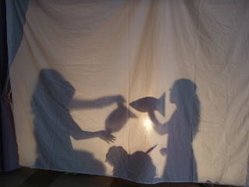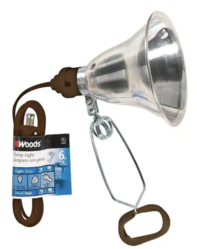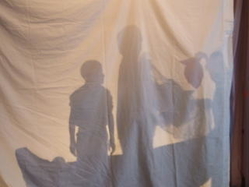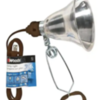SHADOW DRAMA, SHADOW THEATER - HOW TO & RESOURCES
The following is a compilation of great ideas and tips from members Deborah Diehl, SheilaB, Jaymie Derden, Amy Crane, Luanne Payne, Neil MacQueen, and CreativeCarol. Your additional suggestions are welcome!
What is "Shadow Theater" ?
It's a fun and surprisingly simple way to "put on a drama" in the classroom.
Rather than acting and speaking parts, students pose and move behind a backlit sheet --dramatizing/posing what's being heard in the narration.
- No scenery.
- No elaborate props or costumes needed.
Because you only see the shadow of the prop, a stick can be a spear, a 2x4 can be a cross, and a bathrobe or piece of cloth can be the costume. - No reading or remembering lines.
Only the narrator(s) need to know how to read. - Doesn't need much rehearsal.
- Emphasizes body language (shape that conveys emotion) rather than facial expressions (which can't be seen).
- Just a bedsheet and a bright light for set up.
- And no audience is required.
Instead, you can just record the play and watch if afterward with your shadow actors (great discussion opportunity).
All of these reasons make it the perfect method of dramatizing a Bible story in Sunday School where you don't know how many kids you're going to have, or where age-range is an issue.
MORE REASONS TO USE SHADOW THEATER to DRAMATIZE STORIES:
- Acting behind a screen feels exotic to all ages and gives them a degree of anonymity that allows them to be less self-conscious.
- It's good for younger kids who can't handle much dialogue and for kids who are shy about speaking parts.
- This type of drama is great for presenting the BODY LANGUAGE of a story, how Moses "felt" or the Prodigal Son's humility.
- Children can take on multiple roles because they can simply change a prop to become another character in the drama.
- If you don't have enough kids for crowd scenes (like Jesus' disciples on the boat), you can make simple "cardboard cut outs" to cast shapes of more disciples if you want to.
- After dramatizing the story, you can then dramatize key reflections, like "what would two people look like who were fighting, then decided to approach each other and forgive -- like Jacob and Esau." Or in a Genesis 2 lesson: "What does blame look like? What does humility look like?"
- Encourages students to show the emotions and attitudes in the story.
HOW TO MAKE THE SHADOW SCREEN:
 A White Bed Sheet Is Perfect!
A White Bed Sheet Is Perfect!
Shadow screens can be narrow or wide, just keep in mind that the bigger the sheet, the more 'wide' light you'll need.- Shadow sheets fixed to a wood frame or hung with rope between posts or walls. They can be hung in a doorway or dropped from a curtain rod that's fixed between two posts or suspended from the ceiling. Use a method that will have the sheet reasonably taut and secure.
- Plastic Shower Curtains can also be used. Stretch it over a PVC pipe or wood frame and attach with clips or tape.
SHADOW SCREEN LIGHTING:
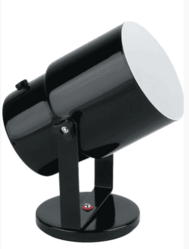 You need a bright light positioned behind the actors. The bigger your screen and the more actors you have, the brighter the light you will need. (Having 2 lights creates competing shadows).
You need a bright light positioned behind the actors. The bigger your screen and the more actors you have, the brighter the light you will need. (Having 2 lights creates competing shadows).- You will "focus" your shadows on the screen by adjusting the distance of the actors and light from each other and the screen. Place marks on the floor to remind them where and "where not" to stand.
- Use inexpensive clamp lights or a spotlight that sits on the floor. Use a "flood light" style of bulb if possible. 100 watt "flood" bulbs in a clamp light worked the best. They have a wide angle and the outer edge of the light beam is brighter than with a standard lightbulb. The LED versions are cooler and typically have a good "white" light. The higher the wattage, the brighter the backlit screen and sharper the shadows will be.

- Put a switch on the light's cord so that the teacher can control when scenes start and end (if desired).
Shadow dramas usually use a script spoken by off-screen narrators. These scripts are usually created by the teacher from the scripture passage -- and made more dramatic with embellishments. Storybook Bibles and online scripts (such as some of those found here at Rotation.org), are a good way to build a script that works for you.
When creating your script, include or emphasize "action words" that can serve as CUES to the actors. Pause and emphasize those words as you narrate, and remember to leave space for the actors to do their thing before continuing your reading.
You can also create your own by looking up the story in THE VOICE version of scripture which breaks down stories like a script. You can see a good example of The Voice's translation/format for Lazarus' story here.
- Children's Bible storybooks are often a good place to start too. Read the story, then have the kids re-enact it.
- First, read them the story and discuss it. Then re-read the story and have the children take turns (may do it in groups if you have a large group) they act it out as you read. You can add to the story drama by adding exaggerated movements to your dialog. For example, for the Good Samaritan... The priest RAISED HIS ARMS in surprise. Then he LOOKED SLOWLY TO THE RIGHT AND SLOWLY TO THE LEFT to make sure no one was watching...
ACTING BEHIND A SHADOW SCREEN
- Rehearsal is helpful. Listen and discuss the narration.
- Suggest and practice poses.
- "Hold" your pose, don't move too quickly.
- Pay attention to where you're standing. Don't get too close to another actor or to the light or to the screen. (You'll figure these things out during rehearsal).
- Depending on your presentation, you may either change your scene while the light is on, or do it while the light is off.
MAKE A VIDEO RECORDING OF YOUR DRAMA!
- Kids love to see themselves, it's fun, and it's a good opportunity to discuss and reflect.
- Recording the drama also gets rid of the need for an audience.
- Your shadow theater video can also be shared on the church's social media without "privacy" concerns (because the kids' faces are not seen).
Recording Tips:
- Use a late-model cellphone or video camera that is good in low-light conditions.
- Put the camera on a tripod to maintain a stable focus on the screen.
- Have the narrator stand near the camera's microphone for clearer audio.
- Make sure you have a powercord for the camera AND a cord to plug the camera into a larger screen for viewing by the class!
- Most cellphones don't "pause" the recording, they stop it. So if you have many scenes in your shadow drama, and stop the camera in-between each scene, you will end up with a series of video files to view. In this case, you may just decide to "let the camera keep recording" and keep your time between scenes very short.
- If you have an actual video camera, or high-end camera that takes video, it mostly like has a "pause" button that allows you to pause the recording and still end up with only one file to show.
OTHER WAYS TO USE The SHADOW SCREEN TECHNIQUE:
- Freeze Scenes
Your shadow drama may also be done with "stills." In other words, the children get in position and hold that position while the narration occurs, like a photograph. Then for the next scene, they get into a new position and hold that position. (Have someone take photos of each scene and you can create a movie of your story.) - Puppets
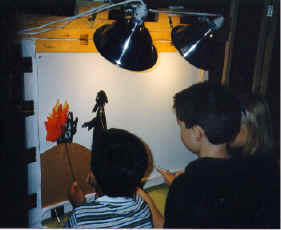
Shadow plays may also be done with puppets. For a puppet shadow drama the white sheet is just large enough to cover the front of the puppet area and once again is taut and secure and the light definitely shines from the back. Keep in mind when you are using puppets for the shadows, you may want to use a puppet that gives definition to the shadow.
Read more about Shadow puppets at this link.

